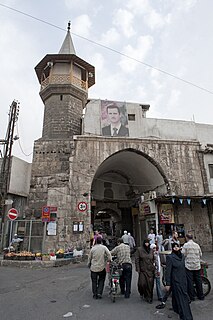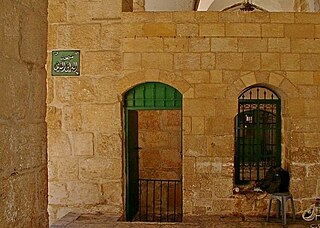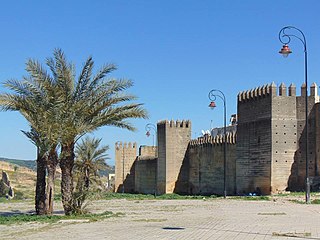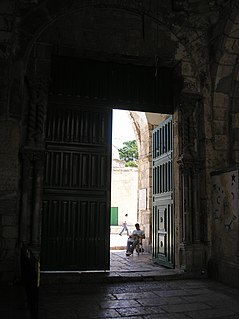Bábism, also known as the Bábi Faith, is a monotheistic religion which professes that there is one incorporeal, unknown, and incomprehensible God who manifests his will in an unending series of theophanies, called Manifestation of God. It has no more than a few thousand adherents according to current estimates, most of whom are concentrated in Iran. It was founded by ʻAli Muhammad Shirazi who first assumed the title of Báb from which the religion gets its name, out of the belief that he was the gate to the Twelfth Imam. However, throughout his ministry his titles and claims underwent much evolution as the Báb progressively outlined his teachings.

The Gates of Cairo were gates at portals in the city walls of medieval Islamic Cairo, within the present day city of Cairo, Egypt.

The Sublime Porte, also known as the Ottoman Porte or High Porte, was a synecdoche for the central government of the Ottoman Empire.

Bab Zuweila or Bab Zuwayla is one of three remaining gates in the city wall of the Old City of Cairo, the capital of Egypt. It was also known as Bawabbat al-Mitwali during the Ottoman period. It is considered one of the major landmarks of the city and is the last remaining southern gate from the walls of Fatimid-era Cairo in the 11th and 12th century.

Bāb aṣ-Ṣaghīr, also called Goristan-e-Ghariban, may refer to one of the seven gates in the Old City of Damascus, and street in the modern city of Damascus, Syria. It has qubûr on either side of the road, and is located in the Dimashq Neighborhood, southwest of the Umayyad Mosque.
The term bāb was used in early Shia Islam for senior disciples, and authorised deputies, of the current Imam. Less commonly, the term is also applied to the Imams themselves, as well as to Muhammad and other prophets in Islam.

The Temple Mount, located in Jerusalem, has twelve gates, one of which, Bab as-Sarai, is now closed to the public but was open during Ottoman rule. There are also six other sealed gates. This does not include the Gates of the Old City of Jerusalem which circumscribe the external walls except on the east side.

Bab Tuma is an area of the Old City of Damascus in Syria, and is also the name of one of the seven gates inside the historical walls of the city, which is a geographic landmark of Early Christianity. The gate was named by the Byzantines to commemorate Saint Thomas the Apostle, one of the twelve apostles of Jesus Christ. The Romans first built the seven gates, and during their era, the gate was dedicated to Venus. The current gate was reconstructed by the Ayyubids in the 13th century.

Bab al-Faraj, meaning the Gate of Deliverance or Bab al-Faradis was one of the 9 main gates of the ancient city walls of Aleppo, Syria. It was located at the northern side of the ancient city. The gate was ruined in 1904. Some remains are still found at the north-eastern part of the gate.

Bab al-Faradis or Bab al-Amara is one of the seven ancient city-gates of Damascus, Syria. The other name, Bab Al-Amara, refers to a name of a district in the old city where people in the 14th century would meet. During the Roman era, the gate was dedicated to Mercury.

Bab al-Jabiya is one of the seven ancient city-gates of Damascus, Syria. During the Roman era, the gate was dedicated to Mars. Bab al-Jabiya was the main entrance on the city's west side. The gate opens on Medhat Pasha Souq, which is the modern western half of the Street Called Straight, the Roman east-west artery (decumanus), which still connects it to Bab Sharqi. The gate's modern name dates to the Umayyad period and comes from the name of Jabiyah in the Golan Heights, then the capital city of the Ghassanids, allies of the Roman Empire.

Bab al-Futuh is one of three remaining gates in the city wall of the old city of Cairo, Egypt. It was finished in the year 1087 and faces north. The other two remaining gates are Bab al-Nasr in the north and Bab Zuwayla in the south. Bab al-Zuwayla and Bab al-Futuh are located on Muizz Street in Cairo.

Bab al-Nasr, is one of three remaining gates in the historic city wall of Cairo, the capital of Egypt. The gate's construction is dated to 1087 and was ordered by Badr al-Jamali, a Fatimid vizier. It is located at the northern end of Shari'a al-Gamaliya in the old city of Cairo and slightly east of another contemporary gate, Bab al-Futuh.

The al-Buraq Mosque is a subterranean mosque next to the Western Wall, located in the southwest corner of the Masjid al-Aqsa compound in the Old City of Jerusalem. This mosque is called al-Buraq Mosque because of a ring that is nailed to its wall where Muslims believe Muhammad tied the Buraq that carried him from the al-Haram Mosque to the al-Aqsa Mosque during the Night Journey.

Bāb Ḥuṭṭa is a neighborhood in the Muslim Quarter of the Old City of Jerusalem to the north of the Haram al-Sharif. The name literally means "Forgiveness Gate", referring to the Forgiveness Gate of the Haram compound, connected by Bāb Ḥuṭṭa Street.

The Alcázar of the Caliphs or Caliphal Alcázar, also known as the Umayyad Alcázar and the Andalusian Alcazar of Cordoba, was a fortress-palace (alcázar) located in Córdoba, in present-day Spain. It was the seat of the government of Al-Andalus and the residence of the emirs and caliphs of Córdoba from the 8th century until the 11th century and the residence of local Muslim governors from the 11th century until the Christian conquest in 1236. The site was composed of heterogeneous constructions ranging from the private residences of the rulers and their households to the government offices and administrative areas. Today, only minor remains of the palace have survived, including the Caliphal Baths which have been converted into a museum. The rest of the site is occupied by later structures including the Alcázar de los Reyes Cristianos, the Episcopal Palace, the Seminary of San Pelagio, and the Campo Santos de los Mártires public square.

The Fortifications of Fez comprise a complex circuit of ramparts and gates surrounding Fes el-Bali and Fes el-Jdid, two urban agglomerations that compose the old "medina" of Fes, Morocco. They also include a number of kasbahs (citadels) and forts which were built both to protect and to control the city. These fortifications have been built up over many centuries and the extensive remnants today date from many different periods.

Bab Dekkakin or Bab Dekakene is a fortified and ceremonial gate in Fes, Morocco. The gate is situated between the Old Mechouar and the New Mechouar on the northern edge of Fes el-Jdid.

The Walls of Marrakesh are a set of defensive ramparts which enclose the historic medina districts of Marrakesh, Morocco. They were first laid out in the early 12th century by the Almoravid dynasty which founded the city in 1070 CE as their new capital. The walls have since been expanded several times by the addition of the Kasbah to the south at the end of the 12th century and by the later extension of the walls to encompass the neighbourhood around the Zawiya of Sidi Bel Abbes.

The Chain Gate is one of the gates to the Al-Aqsa Mosque compund on the Temple Mount in the Old City of Jerusalem. It was previously known as David's Gate. It was also known as Bāb al-Maḥkama, named after the nearby Tankiziyya.
















